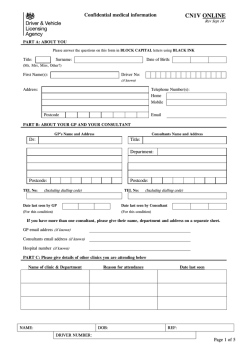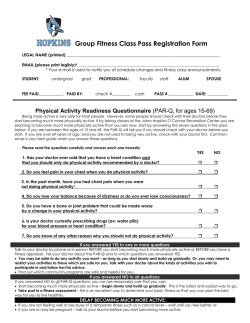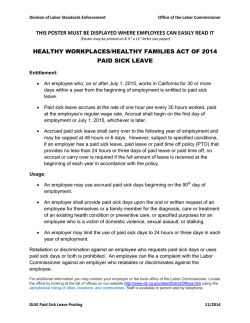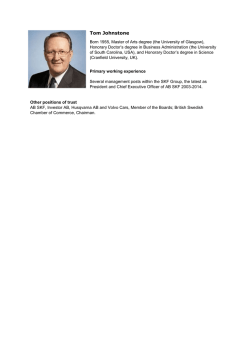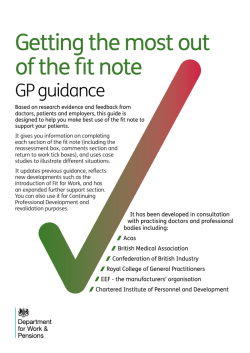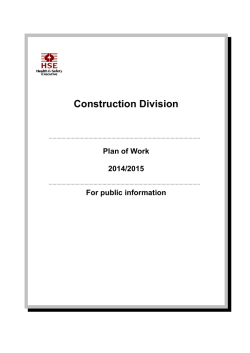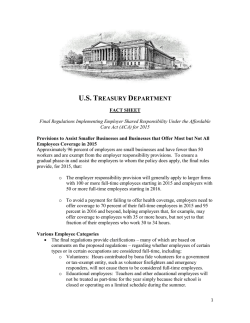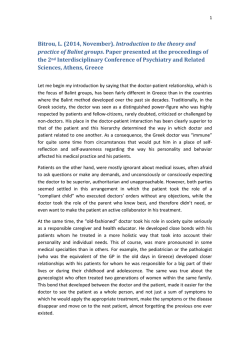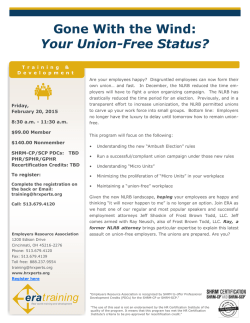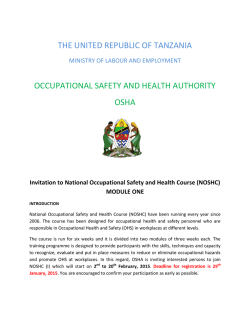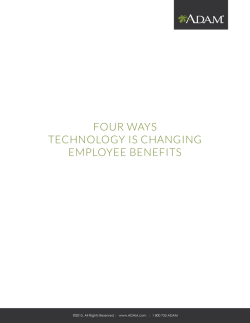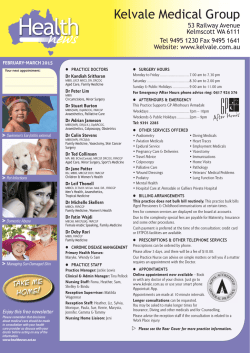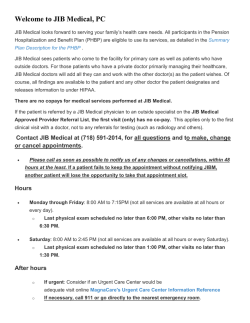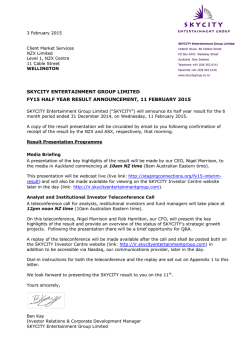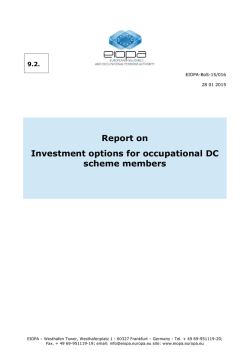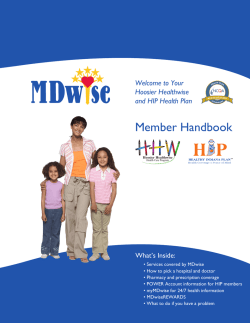
Guidance for employers and line managers
Getting the most out of the fit note Guidance for employers and line managers This guide explains what to do if you’re given a fit note by an employee. It explains what different sections of the fit note mean, and how you can use it most effectively to help your organisation. It has been developed in consultation with practising doctors and professional bodies including: Acas British Medical Association Confederation of British Industry Federation of Small Businesses Royal College of General Practitioners EEF - the manufacturers’ organisation Chartered Institute of Personnel and Development 2 Getting the most out of the fit note The fit note – the basics Five things to do if you’re given a fit note Key things to keep in mind 1. Check whether your employee’s doctor has assessed that they are not fit for work, or may be fit for work. 2. Check how long your employee’s fit note applies for, and whether they are expected to be fit for work when their fit note expires. 3. If your employee may be fit for work, discuss their fit note with them and see if you can agree any changes to help them come back to work while it lasts. 4. If your employee is not fit for work, or if they may be fit for work but you can’t agree any changes, use the fit note as evidence for your sick pay procedures. 5. Consider taking a copy of the fit note for your records (your employee should keep the original). • There is more information in the rest of this guide about: • • • • • How the fit note can help you 3 The evidence behind the fit note 3 General rules of the fit note 3 What to do if a fit note says not fit for work 4 What to do if a fit note says may be fit for work taking account of the following advice 4 The tick boxes 6 The comments box 6 Possible changes 6 Explaining the sections of the fit note 7 Additional questions 9 Further support • 11 • • • • Supporting someone with a health condition to come back to work can save you money and minimise disruption. People can often come back to work before they are 100% fit - in fact work can even help their recovery. Often, a few simple and / or low-cost changes can help someone with a health condition come back to work earlier. Access to Work can help employees with a disability or health condition. This includes paying towards equipment or support. If your employee is assessed as may be fit for work, their fit note will help you discuss with them what these changes might be. The fit note won’t tell you what changes to make, but will give you advice about how your employee’s health affects what they can do at work. If you can’t make any changes to take account of the advice in the fit note, you don’t have to. The fit note tells you whether your employee is expected to be fit for work at the end of their fit note. If your employee’s doctor thinks they are fit for work, they will not be issued with a fit note. Your employee can come back to work at any time, even if this is before their fit note expires. They do not need to go back to their doctor first. The fit note belongs to your employee and they should keep the original. You may decide to take a copy for your records. Guidance for employers and line managers 3 How the fit note can help you Using the fit note to its full potential helps you reduce your sickness absence costs (for example sick pay, staff cover and lost productivity), and minimises the disruption caused by employees being off sick unnecessarily. • • • • The fit note tells you whether your employee’s doctor thinks they are not fit for any work or whether they may be fit for work (not necessarily their current job). The advice in the fit note is about your employee’s fitness for work in general, and not specifically about their current job. This gives you maximum flexibility to discuss possible changes to help them return to work (which may include changing their duties for a while). The fit note also tells you whether your employee is likely to need a new fit note when their current one expires. The evidence behind the fit note The fit note is based on key principles established by a robust research base1, and supported by healthcare professionals2: • Appropriate work is usually good for people’s physical and mental health. • This is also the case for people who have a health condition - work can support their recovery and help them maintain their wellbeing. • In most cases, people do not need to be 100% fit to return to work. This may not mean doing their normal job. • People with health conditions may have limits on what they can do at work, but these will not always mean they cannot do any work. General rules of the fit note People can only be given a fit note if their doctor considers their fitness for work is impaired. If someone is fit for work, they will not be given a fit note. Doctors cannot issue fit notes during the first seven calendar days of sickness absence. Employees can self-certify for this time (there is a template form available at https://www.gov. uk/government/publications/statutory-sick-payemployees-statement-of-sickness-sc2. If your organisation requires medical evidence for the first seven days of sickness absence, it is your responsibility to arrange and pay for this. Fit notes can be handwritten or printed, but must always be signed by a doctor. If they are printed, you can scan the barcode using a 2D matrix scanner so that you can add it to your sickness records. It also confirms that the fit note is genuine. If a GP has issued a fit note, it should include the address of the practice. If a hospital doctor has issued the fit note, you may also receive a yellow Med 10 form stating the time your employee has spent as a hospital inpatient. “Work improves people’s health if they’re in a job that gives them satisfaction, income and routine in their day – it can be very beneficial for most people to go back to work.” (GP) 1. W addell, G. and Burton, A.K. (2006), Is work good for your health and well-being? TSO https://www.gov.uk/government/uploads/system/uploads/attachment_data/file/214326/hwwb-is-work-good-for-you.pdf and Waddell, G., Burton, A.K. and Kendall, N.A.S. (2008). Vocational Rehabilitation TSO https://www.gov.uk/government/publications/vocational-rehabilitation-scientific-evidence-review 2. Healthcare Professionals’ Consensus Statement – Statement of Health and Work (2008). https://www.nhs.uk/Livewell/workplacehealth/ Documents/hwwb-healthcare-professionals-concensus-statement-04-03-2008.pdf 4 Getting the most out of the fit note What to do if an employee gives you a fit note If your employee’s fit note says that they are not fit for work… You should treat this as evidence for your sick pay procedures (see more information about sick pay here). You can take a copy of the fit note for your records, but your employee should keep the original as they may need it for benefits or other purposes. Your employee’s fit note will tell you how long they will not be fit for work, and whether they can expect to return to work as before once it expires. See explaining the sections of the fit note for more information. It’s a good idea to keep in touch with your employee while they are away. Guidance on managing sickness absence is available from the Health and Safety Executive and British Occupational Health Research Foundation. If your employee’s fit note says that they may be fit for work… You should discuss with your employee whether there are any changes which could help them return to work. These discussions can involve line managers, HR, trade unions or occupational health specialists. You can take a copy of the fit note for your records, but your employee should keep the original as they may need it for benefits or other purposes. You do not need to be an expert in your employee’s health condition to have these discussions – they should be focussed on practical ways that you could support your employee to return to work, rather than their health condition. The checklist below may be helpful in preparing for your discussions: • Look at the tick boxes and comment box for advice on what your employee can do at work, and how you can support them • Consider how long your employee’s fitness for work is expected to be affected (check Explaining the sections of fit note to see how you can do this). • Think of possible changes to help your employee return to work It may be helpful to put any changes you agree down in writing, so that everyone is clear on what has been agreed. In general, any changes should last at least until the fit note expires – although this will depend on the advice in the fit note and your discussions with your employee. See some examples of employers making changes to support someone to return to work. You may need to carry out a risk assessment to accommodate the clinical judgment in the fit note (eg if it states that your employee should avoid lifting, you are liable if you give them work that involves manual handling). Guidance on risk assessments is available on the HSE website If you can’t agree on any changes, you should treat the fit note as if it says that your employee is not fit for work and use it as described above. Your employee does not need a new fit note from their doctor to confirm this. See an example of this situation. Guidance for employers and line managers Fit for Work If your employee has been off work sick for four weeks, or their GP thinks they are likely to be off work that long, they can refer them to Fit for Work, though a fit note may be required to cover the first two weeks of sickness absence. They will get an assessment that will provide advice on interventions and steps on a Return to Work Plan to help support them back to work. The Return to Work Plan will be shared with their GP and employer, subject to the employee’s consent. A Return to Work Plan can be used in place of a fit note. See case study three for an example of a situation when it may be appropriate to refer someone to Fit for Work. As an employer you can make a referral to a Fit for Work assessment if the GP has not already done so after 4 weeks. You can also access the advice line or use their website to get general health and work advice. Contact information and website details are on page 11 of this guidance. “We’re seeing a cultural change in terms of line managers talking to staff about return to work. The fit note gives them something to base these discussions on, and feel more confident about having them.” (Employer) 5 6 Getting the most out of the fit note Supporting your employee back to work The tick boxes Possible changes The tick boxes enable your employee’s doctor to indicate the kind of general adaptations that might help your employee return to work. This is not binding on you, and you should feel free to discuss other options. • A phased return to work: a gradual increase in work duties or hours • Altered hours: changing their work times or total hours • Amended duties: changing their work duties • Workplace adaptations: changing aspects of the workplace There is a wide range of support available to help you make changes. Check the Further support pages for additional help and condition-specific guidance. The comments box Your employee’s doctor may also use the comments box to give you more detailed advice about what your employee can do at work. This advice will be about their general fitness for work, not just related to their current role, so that you have maximum flexibility to consider how you could support them to return to work. If there are particular parts of your employee’s role that may be affecting their health, these will be mentioned in the comments box. Some examples of possible changes are listed below - remember that this list is not exhaustive, and the best changes are ones that are tailored to your organisation and your employee. • Changing to a different job or location • Changes to work equipment • Reduced or flexible hours • Adjustments to work premises • A phased return to work • Giving some of their tasks to somebody else • Providing training or additional supervision • Providing a reader or interpreter • Working from home • Voice-activated software • Arranging a mentor or work buddy • Working in a team instead of by themselves (or vice versa) • Arranging for an occupational health assessment. If your employee’s GP thinks that a referral to Fit for Work is useful, they can record that they made that referral. If they decide the patient is eligible but has decided not to refer to Fit for Work they can record their reasons for not doing so. “GPs typically are not occupational health specialists and can’t be aware of every job that every employee does. The joy of the fit note is that it’s flexible enough for us to interpret and fit the GP’s recommendation within the context of our business.” (Employer) “(Changes are) something that people agree with their manager. We encourage the manager and the employee to work out what’s best because they have to determine what’s best for them.” (Employer) 6 7 8 5 4 3 2 1 Explaining the sections of the fit note 7 Getting the most out of the fit note Guidance for employers and line managers 7 8 Getting the most out of the fit note 1The date your employee was assessed by their doctor. This could be a face-to-face or telephone consultation, or consideration of a written report from another doctor or healthcare professional. 7The dates in this section (including any which cover an early period) can be for any period that your employee’s doctor considers appropriate. 8 This box tells you whether your employee’s health condition is expected to affect them after their current fit note expires. 2The condition(s) affecting your employee’s fitness for work. 3The doctor’s assessment as to whether your employee is either: • Not fit for work - Your employee is not fit for work of any kind. OR • May be fit for work taking account of the following advice - Your employee may be fit for work, taking account of the doctor’s advice in the fit note. This does not necessarily mean doing their normal role. 4The doctor’s advice about how you can support your employee to return to work. See the tick boxes and the comments box for more information. 5A GP can record whether you have made a referral to Fit for Work here, or their reason for not referring, if relevant. 5 The period that the fit note covers. This will either be from the date of the assessment (Box 1), or between particular start and end dates. The dates are inclusive, (so a fit note dated from 2 April to 10 April will no longer apply from 11 April onwards). 6This section may cover an earlier period if your employee’s doctor judges that their condition affected their fitness for work before the assessment date. I will not need to assess your fitness for work again at the end of this period Your employee’s health condition is not expected to affect their fitness for work once the fit note has expired. I will need to assess your fitness for work again at the end of this period Means your employee’s health condition may still affect their fitness for work beyond the end of the fit note (so they may need a new fit note at that point). 9Your employee’s doctor needs to sign the fit note. 10The date the fit note was issued – this may not always be the same as the date of the assessment. IMPORTANT: Your employee can go back to work at any time (including before the end of the fit note) without going back to see their doctor - even if their doctor has indicated that they need to assess them again. This will not breach your Employers Liability Compulsory Insurance, providing a suitable risk assessment has taken place if required. “You don’t want to go down a road where everything centres around your health. You want to have a life apart from that and that’s the good thing about going back to work – you’re dealing with people and you have a routine to your life again.” (Patient) Guidance for employers and line managers 9 Additional questions Does my employee need a fit note saying they are fit for work? What should I do if I do not understand the advice on the fit note? No. People do not need to be signed back to work and there is no option on the fit note to do so. If your employee’s doctor assesses that they are fit for work, they will not be issued with a fit note. First, see if your employee can provide any more information. If you are still unsure, you could consider advice from an occupational health specialist. You can write to the doctor for more information although you may have to pay for this service and doctors may not be able to respond immediately. Your employee should return to work once their fit note expires (if they have not already done so) or will need a new fit note. For a limited number of jobs, there are separate procedures to ensure someone is fit to carry out their role. Your HR, occupational health or legal department should know if this applies to your organisation. If your organisation has a separate policy which requires someone to obtain medical evidence that they are fit for work, this should be arranged through a private arrangement with a GP or occupational health specialist. Once your employee’s doctor has assessed them as fit for work, they cannot issue any further fit notes to cover a period while they are waiting for additional health checks required by your organisation. What if a fit note says my employee’s job may be affecting their health? You should consider this carefully and bear in mind your responsibilities under health and safety regulations. The law requires you to record work-related injury and illness and report certain cases to the relevant enforcement authority. It is very easy and straightforward to do this – you will find all the information you need at www. hse.gov.uk/riddor/index. What if a fit note recommends that I seek occupational health advice? It is your decision whether to act on this advice and in some cases you may be able to support your employee without needing additional expertise. For complex and / or possible workrelated conditions, support from occupational health specialists should be seriously considered. What should I do if I offer support to an employee and they refuse? Your first step should always be to ask your employee why they believe they cannot return to work, as there may be something you have not considered. If you can’t reach agreement, you may want to consult an occupational health specialist. If necessary you should consider your organisational policy for absence disputes, which may give you guidance about sick pay rules when suitable work is refused. 10 You can get more information from Acas, and your employee may wish to seek advice from their trade union or an advice centre. How does the fit note affect sick pay? The fit note can be used as evidence for your sick pay procedures. If your employee’s fit note states that they may be fit for work but you agree that they should remain off work, then they can still receive sick pay (because in these circumstances you treat the fit note as if it stated not fit for work). If your employee returns to work on reduced hours, you should consider whether your employee might be financially disadvantaged. In such cases you may decide to pay sick pay for the hours not worked, or to pay full pay despite the reduced hours. More guidance about sick pay is available at www.gov.uk/sick-leave-pay-employees Can I refuse to pay sick pay even if my patient has a fit note? If there is good reason to believe that an employee’s incapacity is not genuine, you can refuse to pay sick pay despite your employee having a fit note. For more information, visit the HMRC website at https://www.gov.uk/statutorysick-pay-employee-fitness-to-work or ring their helpline on 08457 143143. Am I still covered by Employers’ Liability Compulsory Insurance? Your liability insurance does not prevent employees who may be fit for work from returning to work. You should ensure that you take account of the advice in the fit note, perform any relevant safety procedures and consider whether a risk assessment is necessary. Contact your insurer if you have any concerns. Getting the most out of the fit note What if a fit note is for an ‘indefinite’ period but I can’t accommodate any of the advice? You should consider as many ways as possible to help your employee back to work, including moving them to a different role. There may be additional legal issues to consider, for example your duties under the Equality Act. Find out more at https://www.gov.uk/equality-act-2010guidance. Dismissal is a last resort and could be unfair if not handled properly. There is more information at www.gov.uk/dismiss-staff. Ideally you should follow the Acas code of practice at www.acas. org.uk/index.aspx?articleid=2174. Is the fit note binding on me? No. The assessment about whether your employee is not fit for work or may be fit for work (and any other advice in the fit note) is classed as advice, and it is for employers to determine whether or not to accept it. Occasionally, you may believe that your employee is not fit for work when they have been assessed as fit for work by their doctor, or you may think that your employee could do some work when they have been assessed as ‘not fit for work’ by their doctor. In situations like this you are within your rights to gather other evidence about your employee’s fitness for work from other doctors or healthcare professionals. You can choose to give this other evidence precedence over the advice in the fit note. Your employee may disagree with you, and you may need to demonstrate to an employment tribunal why the alternative source of evidence was more acceptable to you than the fit note. “I was actually keen to return to work, and see how people were doing. So it was a personal thing, personal fulfilment more than anything.” (Patient) Guidance for employers and line managers 11 Further support Occupational Health Advice Service Free professional occupational health support for individual patient cases or about occupational health in general. Contact numbers are: England 0800 0 77 88 44 www.health4work.nhs.uk Scotland 0800 019 22 11 www.healthyworkinglives.com Wales 0800 107 0900 www.healthyworkingwales.com Supporting employees with health conditions Access to Work provides practical and financial support to people with a physical or mental health condition or disability to help them keep a job. This can include paying towards aids or equipment; support workers; support services or travel to and in work www.gov.uk/access-towork. The Royal College of Surgeons of England have produced a Get Well Soon resource with practical tips about getting back to work following some common surgical procedures. www.rcseng.ac.uk/ patients/recovering-from-surgery. The Royal College of Obstetricians and Gynaecologists’ website gives advice on returning to work after gynaecological surgery. www.rcog.org.uk/recovering-well/. The Royal College of Psychiatrists provide advice about returning to work after a period of mental ill health, with specific sections for workers, employers and clinicians. http://www.rcpsych. ac.uk/usefulresources/workandmentalhealth. aspx. Macmillan provides information about work and cancer for patients, carers and employers. http://www.macmillan.org.uk/ Cancerinformation/Livingwithandaftercancer/ Workandcancer/Workandcancer.aspx. Occupational health services Occupational health support can be very helpful in complex cases and when work may be affecting your health. Occupational health services are often provided by large employers and sometimes by the NHS or local authorities. Trade or regional business associations may have details of occupational health providers or other sources of help. For details of providers in your area, contact: Commercial Occupational Health Provider Association www.cohpa.co.uk NHS Health at Work www.nhshealthatwork.co.uk/support-forbusiness.asp Society of Occupational Medicine www.som.org.uk Safe Effective Quality Occupational Health Service (list of approved occupational health providers) www.seqohs.org “I had a very good one which was clear that the employee could work mornings the first week and then afternoons, to get them used to working at different times after a lengthy period off work with depression. The doctor had been very good, they’d listed all this and that was incredibly helpful.” (Employer) 12 Managing sickness absence, disputes and sick pay Gov.uk - www.gov.uk/sick-leave-pay-employees The Health and Safety Executive has provided guidance for employers and managers on managing sickness absence and return to work. www.hse.gov.uk/pubns/priced/hsg249.pdf. British Occupational Health Research Foundation has also developed guidance for managing sickness absence and return to work. www.bohrf. org.uk/downloads/Managing_RehabilitationGuidance.pdf. For questions about Statutory Sick Pay you can visit the HMRC website at www.gov.uk/ employers-sick-pay or call them on 08457 143143. The Employer’s Charter helps employers understand what they can do in respect of a number of issues. www.gov.uk/government/ uploads/system/uploads/attachment_data/ file/32147/employerscharter.pdf. For help on avoiding or managing work-related disputes you can contact Acas at www.acas.org. uk or 08457 474747. “(Changes are) something that people agree with their manager. We encourage the manager and the employee to work out what’s best because they have to determine what’s best for them.” (Employer) Getting the most out of the fit note Fit for Work You can access Fit for Work advice and, when available, also make a referral to an assessment by using the following web links and telephone numbers below: England: www.fitforwork.org 0800 032 6235 Opening hours advice: Monday to Friday 8.30am to 6.00pm Opening hours assessment: Monday to Friday 8.30am to 6.00pm Wales: www.fitforwork.org 0800 032 6233 Opening hours: Monday to Friday 8.30am to 6.00pm Opening hours assessment: Monday to Friday 8.30am to 6.00pm Scotland: www.FitforWorkScotland.scot 0800 019 2211 Opening hours advice: Monday to Friday 9.00am to 5.00pm Guidance for employers and line managers 13 Examples of the fit note in action Case study one Case study two An employer makes changes - working from home An employer makes changes - a delivery driver who can’t drive You run a publishing firm with 10 employees. Amir, one of your proof-readers, gives you a fit note saying that he has a common cold and cystic fibrosis, but that he may be fit for work taking account of the following advice, and the workplace adaptations box is ticked. His fit note has a duration of ten days and his doctor has indicated that they do not need to see Amir again once it expires. You manage three people in a delivery company. One of them, Chris, is a driver who has just had laser eye surgery and cannot drive for two weeks. Because the fit note is about someone’s general fitness for work, Chris’s doctor assesses that he may be fit for work taking into account the following advice and ticks the amended duties box. The advice in the comments box reads: Amir cannot travel into the office because he is at high risk of developing a chest infection whilst he has a cold. The increased risk is due to his pre-existing chest condition - cystic fibrosis. He is able work from home during this period. You and Amir discuss his fit note and agree that he should work from home for the next ten days – you email him some work to do, and he does not go on to sick leave. After ten days, Amir has recovered from his cold and goes back to work in his previous duties without going back to see his GP. “We didn’t previously make adjustments. Employees just said, we are off sick so we can’t return to work. The fit note helps a lot more now and I would like to see more people coming back with adjustments.” (Employer) The advice in the comments box reads ‘Dry eyes, may experience temporary blurring of vision. Should not drive for two weeks. Can still perform other reasonable physical tasks. Mental function unaffected. If he uses a VDU he should take regular short breaks as per standard guidance.’ The fit note states that Chris’s doctor will not need to assess him again once it expires, so you plan for him to be back to work as normal at this time. You discuss the fit note with Chris. Although Chris should not drive, his knowledge of the company and its operations means you decide to use him in a back office role for the two weeks. After two weeks his eyesight is back to normal and he goes back to his driving job, without going back to see his doctor. 14 Cases study three An employer makes changes based on a Fit for Work Assessment You are the manager of a local supermarket. One of your checkout assistants, Alice, sends you a fit note saying she has anxiety disorder. Alice’s fit note states that she may be fit for work. The comments box says ‘can perform physical tasks, but she gets anxious when faced with confrontations and difficult customers and should not be left alone’. Her doctor ticks ‘amended duties’. The fit note has duration of two weeks. You make arrangements for SSP to be paid and decide to keep in touch with Alice while she is away so she doesn’t feel cut off. Within a few days of receiving a fit note, you also receive a Return to Work Plan which has been completed by a health professional from Fit for Work. The Return to Work Plan recommends that Alice has a phased return to work starting with just a few hours a day as well as other workplace adjustments which include not having to speak to customers during busy periods. You are happy with these recommendations and arrange for her to do quieter shifts or work away from the shop floor during busier times. Following another recommendation in her Return to Work Plan you also arrange for Alice to attend a course which teaches coping techniques. This is intended to help Alice become more confident when dealing with customers. After four weeks, Alice informs you and her Fit for Work case manager that she feels more confident when dealing with the public and says she would like to return to normal duties. You agree to this and Alice returns to work as normal. Getting the most out of the fit note “There used to be so many situations where you thought to yourself ‘Well there is no option on the form to say this person is probably okay to go back to work but not maybe do their normal job’.” (GP) Guidance for employers and line managers Notes 15 Important information about this leaflet This is only a guide and does not cover every circumstance. We have done our best to make sure that the information is correct as of January 2015. It is possible that some of the information is oversimplified, or may become inaccurate over time, for example because of changes in the law. Published by the Department for Work and Pensions Date: January 2015 www.dwp.gov.uk Doc. no: fitnote_emp_v1.0 Important information about this leaflet
© Copyright 2024

